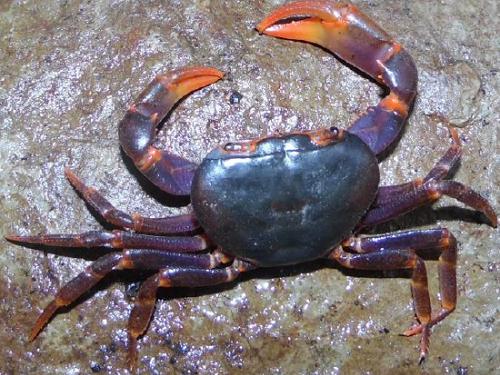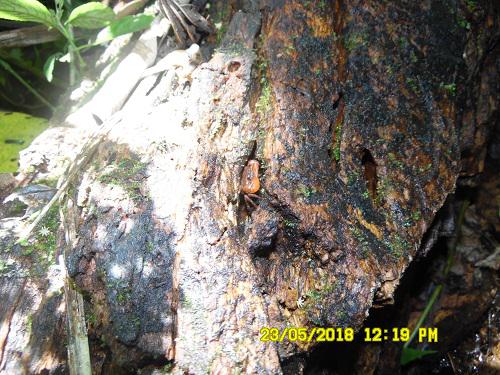Pierre A. Mvogo Ndongo
Other projects
11 May 2015
Comparative Study of Populations of Mangrove Crabs from Six Mangrove Ecosystems in Cameroon: Implications for Conservation
10 Oct 2016
Conservation of the Recently Re-Discovered Endangered Freshwater Crab, Louisea edeaensis (Bott, 1969) on Bedimet Island in the Lake-Ossa Wetlands Complex of Cameroon
24 Sep 2019
Conservation and Assessment of the Extinction Risk of a Threatened New Species of Endemic Freshwater Crab Louisea nkongsamba, from Mt. Nlonako, Cameroon
29 Sep 2021
Conservation and Monitoring Strategies of the Rare Endemic and Threatened Freshwater Crab Louisea yabassi from the Ebo Forest near Yabassi in Cameroon
The project is developed for a conservation plan for the endangered ‘lost’ freshwater crab Louisea balssi that was re-discovered in Manengouba Ecological Reserve in Cameroon after 117 years. The goal is to conserve L. balssi and its habitat through surveying and monitoring that collects data on distribution, population, habitat, and threats for an updated IUCN Red List assessment. Community training to build awareness and involve locals in the management of their aquatic and forest resources is also planned. Long-term monitoring of the Manengouba lakes is proposed as part of the conservation plan because these lakes could potentially release lethal gases.
./86bc4ee090373222f106c47e4c71d6f1.jpg)
Man's Crater Lake Manengouba (potentially endangered).
The potamonautid freshwaters crab genus Louisea Cumberlidge, 1994 is currently represented by two species known only from southern Cameroon (Cumberlidge 1994, 1999): L. balssi (Bott, 1959) and Louisea edeaensis (Bott, 1969). All known specimens of these two species had been collected by German researchers between 1900 and 1910. More recently, the conservation status of both species was assessed using the IUCN’s Red List protocols (IUCN 2003, Cumberlidge et al. 2009) and both were assigned to the endangered (EN) category.

Potamonemus mambilorum.
The first Rufford Small Grant led to the discovery of the lost species L. edeaensis in Bedimet of Lake Ossa and thanks to the ‘Congo Basin Grant program’ we reported more specimens for further taxonomic observations. The second Rufford Small Grant followed up the rediscovery of Louisea edeanensis by implementing conservation measures for this endangered species. During this second Rufford Small Grant, I also rediscovered another lost species, L. balssi that had not been seen since its original collection in 1910, and noticed that the Man’s Crater Lake Manengouba in accumulating lethal gases (Mvogo Ndongo et al. in press). If nothing is done, the Man’s Crater Lake Manengouba may lead to a new natural disaster. In the pass, and in this part of Cameroon, the sudden release of toxic gases from the crater Lakes Monoun (1984) and Nyos (1986) caused the deaths of over 1,700 people and livestock, and destroyed the native fauna and flora, including the aquatic life in the area.

A species of Louisea in a threatened habitat.
The proposed project has four main goals:
1) To establish a conservation action plan for the endangered freshwater crab Louisea balssi (Bott, 1959) which was recently rediscovered after a gap of 117 years. In this respect, I will collect new data on the habitat requirements, population levels, and threats to L. balssi, as well as its geographical range (extent of occurrence) and area of occupancy. These data will be submitted to the IUCN’s Freshwater Crustacean Specialist Group (chaired by Prof. Neil Cumberlidge, USA) who will then organise the formal reassessment of the species and the revision of the Red List extinction risk assessment that will be freely available via the Red List website to the world. Furthermore, I will bring local people (capacity building) to slow down pressure of the forest ecosystem and likewise the crab’s sensitive habitat (as its survival clearly depends on the canopy remaining intact.
2) Biodiversity inventory of freshwater crabs in Manengouba Ecological Reserve. In this respect, I will do more systematic survey work (on behalf of conservation action plan) in lowland and upland zones in Manengouba ecological reserve.
3) This project will help to understand the ecological condition of the Man’s Crater Lake of Manengouba. As a conservationist scientist from Cameroon, it is my job to understand the current ecological situation from the man’s Crater Lake Manengouba by reporting the degree of physico-chemical parameters found there. Because, in the Child and Woman Craters Lakes, the man’s Crater lake is not disturbed by local people, but is hostile to any form of life regarding invertebrates (insects, molluscs, crabs, shrimp etc.) or vertebrates (fish, amphibians, snakes, birds etc.) suggesting accumulation of lethal gases (Mvogo Ndongo et al. in press).
4) To establish a long-term monitoring system in collaboration with local government agencies in charge of nature conservation. In this respect, ‘This project will result in the establishment of a long-term scientific monitoring system for Manengouba’s lakes similar to those that are already in place for the other problematic crater lake Nyos in the Cameroon highlands’. I also plan to involve the Cameroonian Government and other national and international NGOs in charge of nature conservation for a long-term scientific monitoring system. This will contribute to conservation all the fauna (and human beings) living on or around the whole ecosystem of Manengouba ecological reserve by degassing lethal CO2 from this lake to prevent any future disaster from this endangered crater lake.